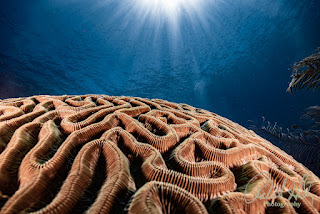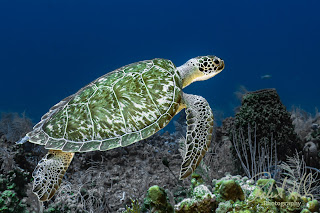Creating Custom Color Profiles for Different Depths with Lightroom AI (Update)
Bringing Back the Color the Ocean Took Away—One Depth at
a Time
You're not alone if you've ever gone through your dive photos and thought, “Where did all the vibrant colors go?”. As underwater photographers, we share this common concern. We constantly strive to bring back the stunning vibrancy and dramatic hues that the ocean seems to keep hidden from our cameras. The deeper we dive, the more we notice that reds, oranges, and yellows seem to disappear, leaving us with murky greens and dull, lifeless blues that hardly capture the true beauty of our underwater adventures.
In my original post from December 2024, I talked about how using custom color profiles could significantly alleviate these color issues using precise editing techniques. However, there’s exciting news! Lightroom has come a long way since then, and with the recent releases of Lightroom Classic versions 14.1 and 14.2, Adobe has equipped us with a fantastic new arsenal of AI-powered tools. These tools make depth-specific editing smarter, more targeted, and far more efficient in helping us restore our underwater images.
In this update, I’m thrilled to guide you through a fresh approach to creating custom AI-enhanced color profiles tailored to different underwater depth zones. Get ready to rejuvenate your photos with color, contrast, and clarity in ways that were previously out of reach. Let’s dive into this together and unlock the true potential of our underwater photography!
What’s New Since the Original Post?
Lightroom Classic versions 14.1 and 14.2 introduced significant
updates that directly impact our underwater editing workflow:
🔍 AI Depth Range Masking
This new mask intelligently identifies and separates
background water based on luminance and focus depth. It targets
distant water columns while protecting the reef or subject detail.
✨ AI Adaptive Presets
(Context-Aware)
These presets are not static—they adapt dynamically to each photo's content. Lightroom “understands” your scene and applies tailored
color and contrast enhancements.
🎨 AI-Guided White Balance
Improved machine-learning models offer brilliant White
Balance suggestions by analyzing light falloff and color cast specific to
underwater environments.
🔧 Enhanced AI Noise &
Sharpen Tools
Low-light and deeper images often suffer from digital grain.
The latest Denoise and Detail sliders apply surgical corrections without
smudging fine textures, such as coral edges or fish scales.
How Color Changes with Depth
Understanding how water filters light is key to building
valuable profiles:
- 0–10
ft (Shallow Waters): Reds and yellows are still visible. Just a minor
correction needed.
- 10–30
ft (Mid-depth): Reds fade rapidly. Greens and cyans dominate.
- 30–60
ft (Deep Zones): Nearly all warm tones disappear. Strong blue cast.
- 60+
ft (The Abyss): Light is scarce. Images rely heavily on strobes and
artificial color recovery.
With this in mind, let’s walk through how to tailor your
editing process using depth-specific AI tools.
Step-by-Step Workflow: Building AI-Enhanced Depth
Profiles
STEP 1: Prepare Your Workspace
Before diving into adjustments, get your workspace in
Lightroom optimized:
- Switch
to the Develop Module
⌨️(Keyboard Shortcut) "D" → Your primary editing interface. - Enable
Soft Proofing
⌨️(Keyboard Shortcut) "S" → Simulates final output for screen or print. - Create
Virtual Copies
Right-click > Create Virtual Copy → Work non-destructively and label each version by depth (e.g., “30ft Coral AI”).
STEP 2: Edit According to Depth
🔺 0–10 ft | Shallow
Waters – “Vibrant Shallows”
Color loss is minimal here, but AI tools can enhance what’s
already strong.
Key Adjustments:
- White
Balance Tool (W)
Select white sand or pale coral to neutralize color temperature. - AI
Adaptive Preset – “Shallow Enhancer”
Automatically increases Vibrance, warms reds/yellows, and sharpens details. - Masking
→ Select Subject
Boost contrast on reef features or fish using Texture +15, Clarity +10.
Optional Add-On:
Add a subtle linear gradient to darken the top third of the water column and
give your scene a cinematic light falloff.
🌿 10–30 ft | Mid-Depth
Range – “Fading Warmth”
This is the range where most color recovery is needed.
Key Adjustments:
- Dehaze
Slider (+15 to +20)
Cuts through suspended particles and increases contrast. - Masking
→ Color Range
Click on faded reds → Boost Saturation +25 to recover fish patterns or coral hues. - HSL
Panel
- Green
Hue: −10 (shift to natural teal)
- Blue
Luminance: +10 (brightens water)
New AI Tool:
Depth Range Masking: Use this to isolate the distant water and reduce
saturation while preserving foreground coral.
💠 30–60 ft | Deep Blue
Zone – “Lost Light Recovery”
Almost all warm tones are gone. You’ll be relying heavily on
AI and temperature shifts.
Key Adjustments:
- White
Balance AI (Auto + Manual Fine-Tuning)
- Temp:
+30 to +40
- Tint:
+5 to +15 (toward magenta)
- Tone
Curve
Add a mild S-curve for better contrast between the diver and the background. - Masking
→ Select Subject
Separate diver or marine life for individual corrections.
Pro Tip:
Use “Select Background” to cool down the water while warming up skin
tones or gear with a second, overlapping mask.
🌊 60+ ft | The Abyss –
“Artificial Light Zone”
Artificial lighting becomes essential; most shots will be
strobe-lit or heavily corrected.
Key Adjustments:
- Calibration
Panel
- Blue
Primary Saturation: −10
- Green
Primary Hue: −5 to −10
- AI
Noise Reduction
- Luminance:
30–50
- Denoise:
Use the enhanced AI slider for better clarity without softening.
- AI
Lens Blur (Beta)
Simulate a narrow depth of field to blur distant blue haze and push attention to your subject.
STEP 3: Save Your Custom AI-Enhanced Presets
Once you’ve dialed in a perfect edit for a specific depth,
save it:
- In the
Presets Panel, click + → Create Preset
- Name
it descriptively: “20ft Green Correction + Subject Pop AI”
- Checkboxes:
Include Basic, HSL, Calibration, and any AI Masks used
- Organize
into a folder like “Underwater Depth Profiles.”
To apply your new preset to other photos:
- In the Library Module, select all relevant images
- Right-click
→ Sync Settings → Choose your custom profile
Bonus: Quick Shortcuts for Efficiency
|
Action |
Shortcut |
|
Develop Module |
D |
|
White Balance Eyedropper |
W |
|
Masking Tool |
Shift + W |
|
Auto AI Adjust |
Shift + U |
|
Soft Proofing |
S |
|
Zoom for Detail Correction |
Z |
Conclusion: Editing with Intelligence Beneath the Surface
What once required the tedious task of adjusting 15 different sliders and a lot of guesswork can now be done with remarkable precision and ease, thanks to the latest AI features in Lightroom. Imagine effortlessly restoring a shallow reef's vibrant, eye-catching reds, effortlessly cutting through the murky greens found at mid-depth, or skillfully reviving a diver's striking silhouette against the ocean's deep blue void. With these innovative, AI-powered tools, you gain a new level of control and unlock limitless artistic possibilities in your edits.
Lightroom’s intelligent technology goes beyond mere automation—it’s like having a creative partner by your side. It actively learns from your underwater images, adapts to their unique content, and guides you in bringing the ocean’s true, vivid colors back to life. Dive into a seamless editing experience where your creativity flourishes and every image resonates with the beauty of the underwater world!
What’s Your Go-To Depth Profile?
Have you created your own presets for different depths? Have you tried the new AI masking tools yet? Comment below and tag your photos with #RobertHerbPhotography—I’d love to see your before-and-after shots!
- 💡 Read more Lightroom tips and get weekly updates when new blogs are published at: Robert Herb Blog.
- 💡 Join my upcoming online training program – Learn to enhance your underwater shots with Adobe Lightroom! Sign up for a FREE "Before & After" Gallery.
- 💡 Share your processed photos on social media using #RobertHerbPhotography.
- 💡 Questions or want help with your Lightroom workflow? Email me at bob@robertherb.com
Written by Robert Herb – Empowering underwater photographers to capture and enhance the beauty of our oceans.
Stay tuned for more in-depth insights into underwater photography. Let’s dive deeper into the art and craft of capturing the marine world! If you have any comments or suggestions, I’d love to hear them.
Get ready for an exciting underwater photography adventure! For more details on my upcoming online training course, check out my "Training" page at RobertHerb.com or email me at bob@robertherb.com.
Sincerely,
Bob Herb
|
|





Comments
Post a Comment
Please let me know your comments.